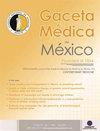[感染艾滋病毒的老年人认知领域的聚类]。
IF 0.6
4区 医学
Q3 MEDICINE, GENERAL & INTERNAL
引用次数: 0
摘要
背景年龄和艾滋病病毒是导致艾滋病相关神经认知障碍(HAND)等疾病的协同风险因素。方法横断面研究纳入了 330 名年龄在 50 岁或以上、在墨西哥城一家三级医院接受治疗的艾滋病病毒感染者。研究使用了一套简短的神经心理学测试来评估各种认知功能。结果参与者的平均年龄为 58.8 岁(SD = 6.6),女性占 12.1%。3 个聚类的解决方案产生了稳定的 Jaccard 系数(p > 0.70)。第 1 群组在视觉和语言记忆领域表现出更明显的障碍,而第 3 群组的参与者则在语言和抽象领域表现出明显的障碍。结论:患有手足徐动障碍的 OAWH 在认知能力方面存在差异。这些差异可能是艾滋病毒相关因素和非艾滋病毒相关因素的个体模式造成的。本文章由计算机程序翻译,如有差异,请以英文原文为准。
[Clustering of cognitive domains among older adults with HIV].
Background
Age and HIV are synergistic risk factors for conditions such as HIV-associated neurocognitive disorders (HAND). Yet, it is unclear whether OAWH display different cognitive profiles for HAND.
Objective
To describe the cognitive patterns of OAWH treated with combined antiretroviral therapy (cART).
Methods
Cross-sectional study that included 330 participants with HIV, aged 50 years or older, cared for at a tertiary care hospital in Mexico City. A short neuropsychological test battery was used to assess a wide spectrum of cognitive functions. The optimal number of cognitive clusters was determined by the silhouette method and a minimization of the Bayesian information criterion.
Results
Participants' mean age was 58.8 years (SD = 6.6), and 12.1% were women. A 3-cluster solution yielded stable Jaccard coefficients (p > 0.70). Cluster 1 showed more significant impairment in visual and verbal memory domains, whereas participants in cluster 3 showed significant impairment in language, and abstraction. Cluster 2 showed no predominance of any domain for alterations.
Conclusions
There are different cognitive profiles among OAWH with HAND. These differences may be due to individual patterns of HIV-related and non-HIV-related factors.
求助全文
通过发布文献求助,成功后即可免费获取论文全文。
去求助
来源期刊

Gaceta medica de Mexico
医学-医学:内科
CiteScore
1.00
自引率
0.00%
发文量
216
审稿时长
6-12 weeks
期刊介绍:
Gaceta Médica de México México is the official scientific journal of the Academia Nacional de Medicina de México, A.C. Its goal is to contribute to health professionals by publishing the most relevant progress both in research and clinical practice.
Gaceta Médica de México is a bimonthly peer reviewed journal, published both in paper and online in open access, both in Spanish and English. It has a brilliant editorial board formed by national and international experts.
 求助内容:
求助内容: 应助结果提醒方式:
应助结果提醒方式:


